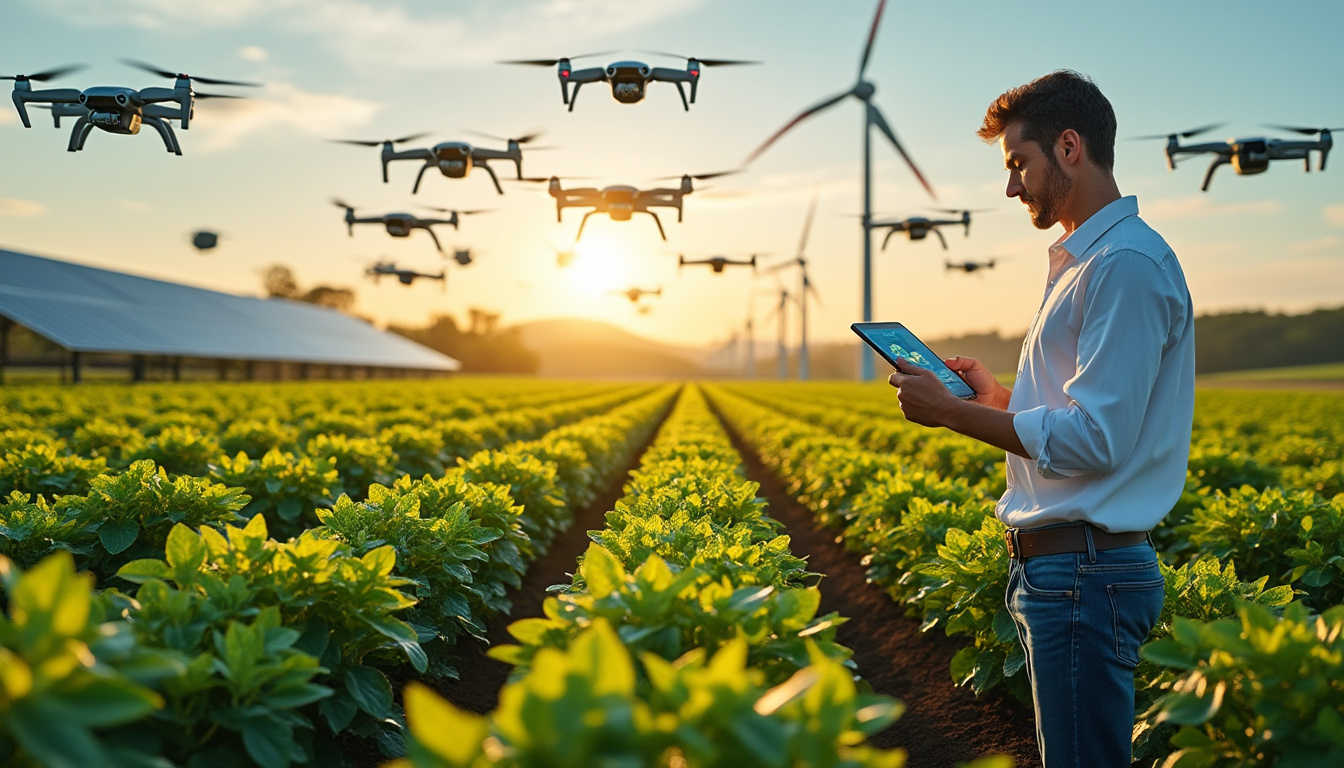At the dawn of this digital revolution, agriculture finds itself at an exciting and complex crossroads. As challenges related to climate change, food security, and soil degradation become increasingly pressing, technological innovations are emerging to transform the agricultural landscape. Through digital tools and smart platforms, tomorrow’s farmers will be able to navigate these challenges with agility and precision. This article explores the alternative pathways that digital technology offers to modern agriculture, from the implementation of technologies such as precision agriculture to the impact of data on agricultural productivity.
The Technological Landscape of Modern Agriculture
Digital technology is redefining the very foundations of agriculture. This term will be used to describe all digital innovations applied to the sector. This new technological landscape is all the more crucial in a world where pressure on natural resources continues to increase. From automated irrigation systems to crop monitoring drones, farmers today have a range of tools at their disposal to optimize their production.The Role of Data in Digital AgricultureOne of the key advantages of this digital age is access to an unprecedented amount of data. This data is not only vast but also varied, encompassing information on climate, soil, and even plant behavior.
DigitalAgri
systems allow farmers to collect, analyze, and use this data to make informed decisions. A report by the Food and Agriculture Organization of the United Nations (FAO) highlights that the effective use of data can lead to significant increases in productivity. FarmBot tools
, for example, allow the automation of many agricultural tasks through data analysis. Improved crop yields.Reduced inputs through precise resource use.
- Increased long-term sustainability of agricultural systems.
- Use Case: Precision Agriculture
- Precision agriculture, also known as PrecisionAg, illustrates how data can be transformed into practical solutions. Using sensors, GPS, and drones, farmers can monitor the health of their crops in real time. For example, applications like HarvestAI offer predictive analytics to support agricultural decision-making. In a context where climate conditions can change rapidly, these tools are essential for optimizing harvests.
A relevant example is a farm in California that integrated sensor systems into its fields. By analyzing soil and climate data, the farmer was able to adjust his irrigation techniques, reducing his water consumption by 30% while increasing his yields.
Technology ImpactApplication Example IoT Sensors Humidity and Temperature Monitoring
Smart Irrigation Systems
| Drones | Crop Condition Monitoring | Field Mapping |
|---|---|---|
| Data Analytics | Yield Forecasting | Harvest Management Tools |
| Digital Innovations for Sustainability | Alongside productivity improvements, | EcoTech |
| in agriculture has become essential to address environmental challenges. The use of digital technologies not only optimizes resources but also meets ever-stricter sustainability standards. Farmers must now ensure that their practices respect not only their profitability, but also the environment. | Sustainable Practices Through Technology | With initiatives such as SmartFarm, modern farms can integrate sustainable practices without compromising productivity. For example, by using artificial intelligence-based forecasting models to predict water and nutrient needs, farmers can reduce waste and conserve resources. |
An optimized crop rotation system can also be planned using digital tools, promoting increased biodiversity and reducing the need for chemical fertilizers. Ultimately, digital farming aims to strike a balance between profitability and environmental responsibility.
Monitoring air and water quality. Managing agricultural waste through digital applications. Using legacy crops in a digital setting.
Sustainability Success Stories
Companies such as AgroConnect have established platforms allowing farmers to share data on sustainable farming best practices. In 2023, a large-scale study showed that farms that integrated these systems reduced their emissions by 40% compared to those that did not. PracticeEnvironmental Impact
Example of Improvement
- Conservation Agriculture
- Improved Soil Quality
- Reduced Use of Chemical Fertilizers
Renewable Energy
Reduced CO2 Emissions Solar Installations on Farms Precision Irrigation
| Water Conservation | Drip Irrigation Systems | The Challenges of Agricultural Digitalization |
|---|---|---|
| Although the benefits of agricultural digitalization are undeniable, significant challenges remain. Digital infrastructure, particularly in rural areas, remains fragile. Furthermore, access to and interpretation of data can be problematic for some farmers, especially those with limited resources. | Inequalities in Access to Technology | Disparities in access to technology are a major obstacle. In many developing countries, farmers struggle to benefit from the advances offered by systems like CropInnov. Initiatives aimed at introducing technologies adapted to local realities must be strengthened. |
| Promote digital education. | Strengthen local infrastructure. | Democratize access to technological tools. |
| Train for the future | Training and support are also essential to overcome these challenges. For example, digital training programs, funded by organizations like the World Bank, are helping thousands of farmers adopt modern technologies. These initiatives not only increase their capabilities, but also enable them to remain competitive in the market. | Initiative |
Objective
Measured Impact
Digital Agriculture Training
Learning to Use Digital Tools Improved Decision-Making SupportSupport Programs
- On-the-Job Technical Support
- Increased Adoption of New Technologies
- Public-Private Partnerships
Developing Tailored Solutions
Better Integration of Innovations in the Sector
| Emerging Trends in Digital Agriculture | As we move toward an increasingly integrated future, several emerging trends promise to further transform the agricultural landscape. Innovative designs for open data systems, improvements in sustainability, and artificial intelligence are leading the major developments to come. | Artificial Intelligence: Driving Innovation |
|---|---|---|
| Artificial intelligence (AI) plays a key role in this evolving landscape, enabling the analysis of colossal volumes of data to derive practical insights. Applications such as | GeoGovia | are leveraging these advances to revolutionize agricultural planning. |
| Thus, AI tools like those developed by | AgriData | help farmers make decisions based on diverse data, strengthening their ability to anticipate market fluctuations. |
| Open Data for Inclusive Agriculture | Another promising trend is open data, fostering greater transparency and collaboration between different stakeholders in the sector. Open platforms allow both small and large producers to share information, creating a stronger agricultural ecosystem. Initiatives such as digital farmer communities are reinforcing this trend, enabling farmers from all walks of life to access comparable resources and services. | Creation of digital farming communities. |
Sharing practices and data among farmers.
Supporting local innovation through shared information.
Trend
Description Examples of applications Artificial intelligence
Big data analysis Yield forecasting tools Open data
Facilitating access to information
Farmer sharing platforms
Sustainable innovations Use of green technologies Renewable energy systems for agriculture
- With the rise of new technologies, digital agriculture is also playing a role in generating research on combating food insecurity and poverty around the world. To maintain this momentum, it is highly likely that public-private partnerships will continue to play a key role in accelerating innovation within the sector.



